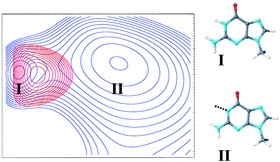Theoretical study of the ground and excited states of 7-methyl guanine and 9-methyl guanine: comparison with experiment
Abstract
The keto–enol tautomerization of 7-methyl-guanine and 9-methyl-guanine in the excited state was investigated using the time-dependent DFT (TDDFT) method. For both species, the potential energy surfaces of the ground state and two lowest singlet excited states (due to π → π* and n → π* transitions) have been investigated and their features discussed in terms of consequences on the excited state dynamics. The findings suggest that, for both species, the state due to the n → π* transition, suspected to be an intermediate in the excited state deactivation, exhibits two minima with the second minimum characterized by an elongated N1–H distance. This structure, intermediate between enol and keto tautomers, might play a role in the excited state relaxation. The existence of this second well, however, is observed in both 7- and 9-methyl-guanine, which suggests that it cannot account alone for the different photophysical behavior of these species.


 Please wait while we load your content...
Please wait while we load your content...